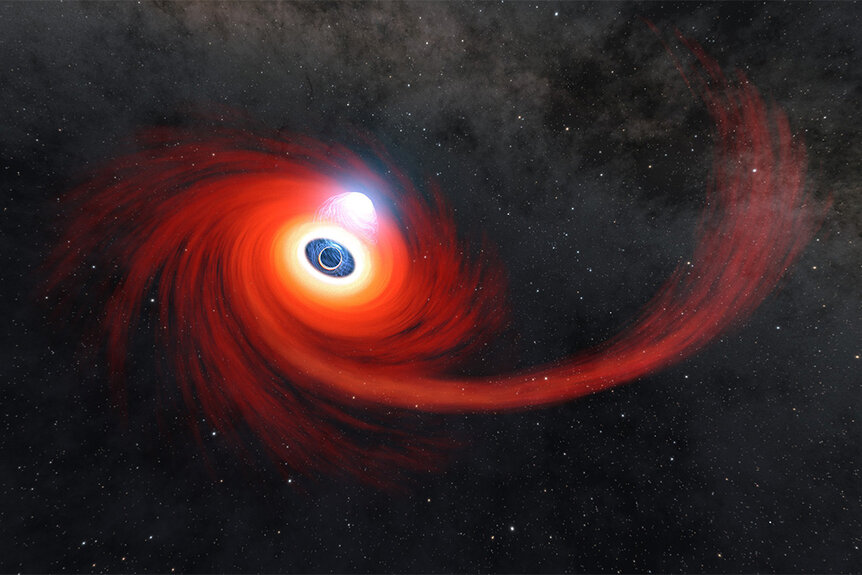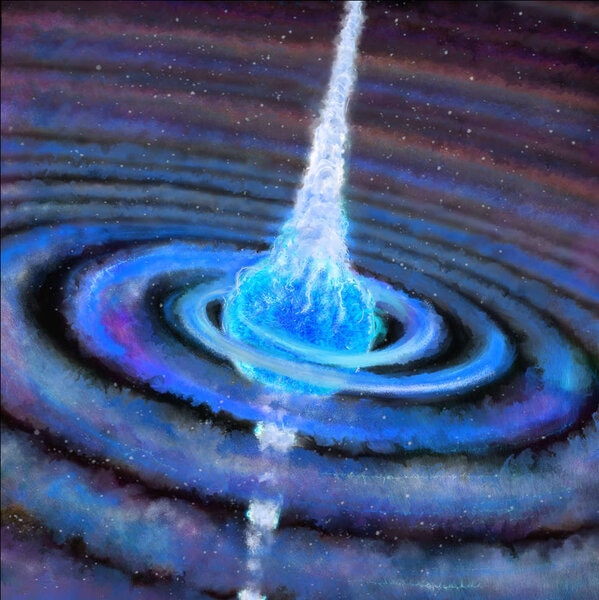Create a free profile to get unlimited access to exclusive videos, sweepstakes, and more!
Parasitic Black Holes Could Be Eating Some Stars (Including the Sun) from the Inside
There is no justice in a universe where stars can get tapeworms.
When John Crichton (Ben Browder) accidentally launched himself to the other side of the cosmos in Farscape (streaming now on Peacock) he encountered all manner of weird places and even weirder creatures. But even his problems, large as they sometimes were, paled in comparison to something which could consume a star from the inside.
Astronomers, including Stephen Hawking, have suggested that a large number of low-mass black holes may have been created in the first moments after the birth of the universe. If that’s true, some of those tiny black holes might set up shop inside of stars and other celestial objects and consume them. A new study published in The Astrophysical Journal ran the models to see what it might look like if a star like the Sun had a low-mass black hole hiding in its heart.
The Universe Might Be Filled with Tiny Parasitic Black Holes
When we think of black holes, we usually think of incredibly massive objects, like humongous stars, collapsing in on themselves at the end of their lives. As a result, conventional black holes have high masses and an outsized influence on the surrounding spacetime.
RELATED: There Might Be Stealth Black Holes Hiding in Our Cosmic Backyard
Low-mass black holes would be much harder to spot, and scientists suggest they could be an explanation for the ongoing mystery of dark matter. They’re also a lot harder to make. Mathematically, a singularity could form at any mass, but you’d have to compress matter to a degree it isn’t usually found in. Put simply, low-mass black holes probably don’t form naturally today, but they might have in the early universe.
In those first instances, less than a second after the Big Bang kicked off, spacetime would have been compressed so tightly that black holes roughly the mass of the Moon or an asteroid might have formed in huge numbers. Some of those might have combined with one another or gobbled up enough stuff to become stellar mass black holes, but some of them could still be out there, in the process of growing. We haven’t found any direct evidence of any parasitic primordial black holes, but the recent study demonstrates that they could exist and tells us what signs to look out for.
What Are the Symptoms of Black Hole Infection?
Having a black hole, even a relatively small one inside of the Sun sounds like a doomsday scenario, but scientists say it might not be anything to worry about. Of course, that depends on the size of your parent star and the size of the black hole inside it.
Simulations showed that some black holes, particularly those on the lower end of the scale, can persist for billions of years inside of a star. If the mass relationship is dramatic enough, the star could even get through its entire natural life cycle relatively unscathed. If that’s the case, we’re going to have a hard time finding them; such a star-black-hole system would look totally normal from the outside. If the internal black hole is more massive though, then things can get interesting.
RELATED: Small Black Holes Near Big Black Holes May Tear Apart and Eat Stars
The models suggested that a black hole about 0.000001 solar masses could exist inside the Sun right now and it would be consistent with what we see. That’s a pretty small decimal, tiny by stellar standards, but don’t let all those zeroes fool you. If you cut the Earth into even thirds (we don’t recommend this) each one of them would be about 0.000001 solar masses.
If such a black hole does exist inside of the Sun or inside of another Sun-like star, we might be able to tell by what happens to it as it ages. Researchers say that the star would rapidly dim to about half of its current luminosity over the next 100 million years as the black hole gobbles up material and stifles fusion reactions.
After that, the star might become fully convective and increase in brightness dramatically. It could stay in this state, announcing its parasitic infection, for billions of years. Then it could become a sub-subgiant star and then a rad straggler, both unusual and rare classes of stars. They are redder and fainter than their peers and we don’t know precisely why they form. A parasitic black hole might be the answer. Finally, the black hole will consume the star in its entirety and only the black hole will remain.
Now that we know what these cosmic parasites might look like, astronomers can design experiments and cue up telescope time to go on the hunt for them. Of course, if we discover that our own star is already infected, we're not sure there’s much we could do about it.
Maybe John Crichton has an idea. Let’s check the record books on Farscape, streaming now on Peacock.
































